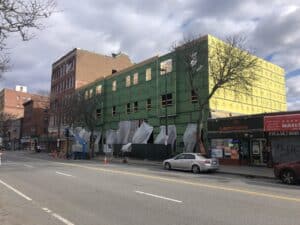
An abandoned building in downtown Lawrence is being converted and expanded into a 39-unit affordable housing development led by Greater Lawrence Community Action Council. Photo by Steve Adams | Banker & Tradesman staff
Growing up in the struggling, post-industrial city of Lawrence, former Mayor Daniel Rivera remembers how the rows of vacant downtown buildings only attracted attention from vandals testing their rock-throwing skills.
“These are places we grew up walking by and we had no expectations they would be productive in any way,” said Rivera, who resigned this month to become CEO of MassDevelopment.
Recent conversions of massive vacant mill buildings into apartments and condos established Lawrence as a Gateway City real estate market with potential, but there was a missing piece to the city’s housing production goals. Local officials and economic development specialists say underutilized office buildings and neglected parcels in the heart of downtown present a compelling opportunity for housing conversions and new construction.
Local developers and community groups have led three current projects adding 83 apartments at three downtown sites, and more than 100 new residences could be completed in coming years at six other sites on Common and Essex streets.
Main Street Benefits Sought
Under Rivera’s tenure as mayor beginning in 2014, Lawrence began to move beyond its reputation for blight and corruption, including a federal grand jury probe of predecessor William Lantigua. More than 2,000 housing units were built or redeveloped during Rivera’s administration, many of them mill conversions by major developers such as Lupoli Cos., Brady Sullivan Properties and WinnDevelopment.
While the projects help address the housing shortage and affordability crisis that engulfs eastern Massachusetts, they’ve been of limited benefit to downtown Lawrence, said Jessica Martinez, MassDevelopment’s transformative development fellow in Lawrence. Many residents of the amenity-rich loft-style riverfront complexes rarely venture into downtown, pointing to the need for more housing conversions, Martinez said. And smaller-scale projects in downtown don’t fit the business models of large development firms.
“It’s the home-grown entrepreneurs who are investing in the buildings with commercial space on the first floor and putting housing units on the upper floors,” Martinez said.
One such entrepreneur is Johan Lopez, a real estate broker for the past 18 years, who broke ground in December on a 28-unit market-rate apartment complex called The Millex at 136 Essex St. The property previously housed a small convenience store.

Lawrence real estate agent-turned-developer Johan Lopez broke ground in December on the Millex, a 28-unit market-rate apartment complex at 136 Essex St. in downtown Lawrence. Photo by Steve Adams | Banker & Tradesman staff
Lopez expects that units in the 5-story apartment building will range from $1,600 to $2,000 per month, and residents’ spending power will benefit local businesses after the project opens in spring 2022.
“When you walk down Essex Street, you’re not going to find many retail spaces available, but it’s still a work in progress,” said Lopez, who is president of the Greater Lawrence Community Action Council’s board of directors. “We still have a long way to go creating some of the amenities that people who occupy those mills are looking for. We need to find a way to keep those tenants in town, and spend their money downtown.”
A third project is under way at 182 Common St., including 16 apartments and a 5,800-square-foot branch of Reading Cooperative Bank as retail anchor.
Expanded Activity After Business Hours
Increasing the downtown population is likely to benefit ground-floor retail businesses, said Evelyn Friedman, executive director of the Greater Lawrence Community Action Council for the last eight years. Despite a small number of ground-floor vacancies, the downtown retail scene continues to lack vibrancy, pointing to the need for more housing, Friedman said.
“In order to revitalize the retail area of Essex Street, you have to have people living here, because those are the people who are going to shop in the small businesses,” Friedman said.
After city councilors dropped plans to relocate the school department offices to a vacant 5-story office building at 370 Essex St., Friedman lobbied Rivera to offer up the property and a neighboring vacant lot to nonprofits for housing. GLCAC was the only respondent that sought to buy both parcels, paying $601,000 for the building in 2018 and kicking off its search for financing.
The $11 million project received low-income tax credits and a $350,000 contribution from the city of Lawrence, and Reading Cooperative Bank issued the construction loan. Scheduled for completion in November, the 39-unit building will include units reserved for households earning 30 to 60 percent of area median income.
Friedman compared downtown Lawrence’s commercial real estate conditions to that of Roxbury’s Nubian Square, where she worked from 1990 to 2008 at Nuestra Comunidad Development Corp.

Steve Adams
“By 6 p.m., the square was fairly dead, because nobody lived near the square,” Friedman said. “Once we started bringing housing to the upper floors, things started to change.”
Reading Cooperative Bank CEO Julie Thurlow said rents for newly-constructed market-rate apartments in Lawrence range from $1,900 to $2,400, reflecting the market can absorb additional inventory.
“There’s been a lack of new housing stock, and multiple generations of families lived together because properties just weren’t available,” Thurlow said. “The preference for these families is that they stay in Lawrence. As more people come in, on the other side of COVID, you’ll see more opportunities for businesses and people who occupy this area.”




 |
| 

